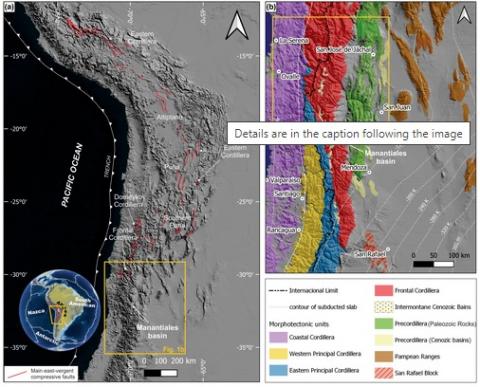Julieta Suriano, Ana C. Lossada, J. Brian Mahoney, Ana M. Tedesco, Carlos O. Limarino, Laura B. Giambiagi, Manuela A. Mazzitelli, José F. Mescua, Lucas Lothari and Rodrigo Quiroga
2 023
Basin Research, Volume35, Issue 6, December 2023, pages 2381-2400
The Eocene compressional phase is well known to have contributed to the construction of the Andes orogen at latitudes north of 30° S, but its extension to the south has not been fully studied. Moreover, synorogenic deposits of Eocene age across the foreland are scarce. The Cenozoic Manantiales Basin records the unroofing sequence of the Andes at 32° S. This study focuses on the basal infill of the Manantiales Basin, informally called the Areniscas Chocolate, which has received less attention than the upper infill until now. Sedimentological, geochronological and provenance studies were carried out on this unit. Here, we present the first ages for the Areniscas Chocolate sequence, of ca. 35–39 Ma (maximum depositional age, MDA). This MDA is interpreted as close to its depositional age, which together with their stratigraphic characteristics, allow us both to separate it from the overlying Miocene Chinches Formation and to propose it as an independent lithostratigraphic unit called Río de los Patos Formation (nov. den.). The provenance analysis of the Río delos Patos Formation indicates a sediment input from western sources located in the Coastal Cordillera and Western Principal Cordillera. Facies associations suggest that the Río de los Patos Formation represents the distal synorogenic deposits during the construction of an Eocene relief to the west. Therefore, the Manantiales Basin started during the late Eocene as a distal foreland basin, indicating that Eocene compression reached latitudes as far south as 32° S. Our results shed light into the characterization of the earliest infill of the Manantiales Basin, as well as into the tectonic evolution of the basin.

